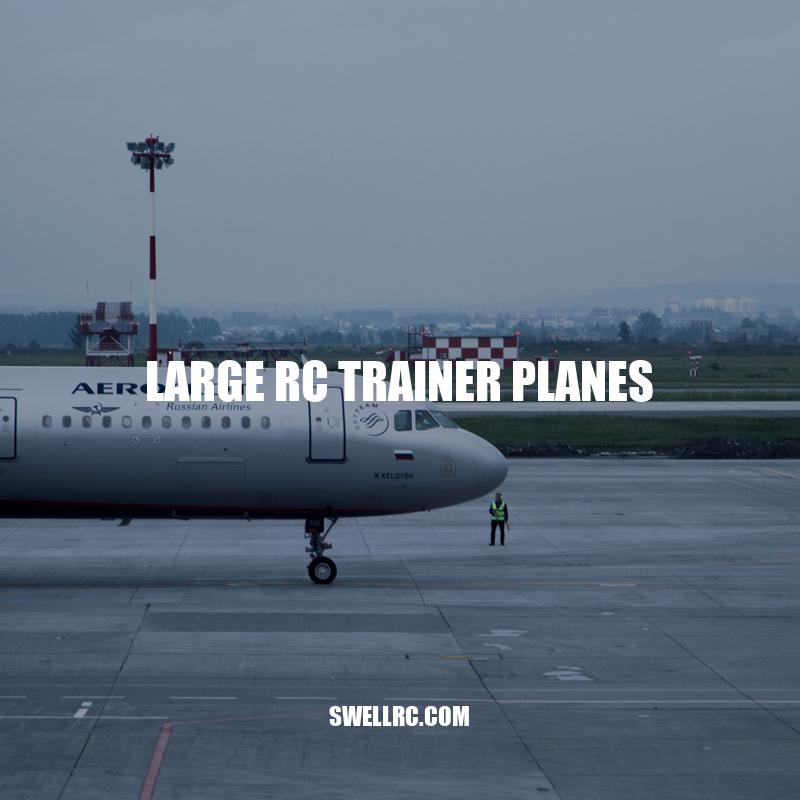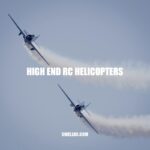Mastering Flight Skills: Guide to Large RC Trainer Planes
RC trainer planes are a fantastic entry point for anyone looking to get started in remote control airplane flying. These planes are specially designed for beginner pilots who want to learn the basics of flying and hone their skills in a safe and forgiving environment. These planes are also a perfect choice for intermediate pilots looking to take their skills to the next level. With a range of options available, beginner pilots can select the perfect plane for their skill level and needs. Large RC trainer planes, in particular, offer an ideal starting point for beginner pilots. These planes have a high-wing design, which increases stability, and a larger wingspan, which provides additional lift, reduces stall speed, and makes them easier to control. On top of that, they have powerful electric motors that can be adjusted in speed and altitude, giving beginner and intermediate pilots complete control over their flying experience. Beginners will find it easy to learn to take off and to land with these planes’ design and construction. Overall, large RC trainer planes provide an excellent opportunity to learn and enjoy the basics of flying a remote control airplane while taking advantage of unique features that make them suitable for both beginner and intermediate pilots. So, you can select the plane that suits your skill level and requirements, get training, and improve your flying skills in no time.
Types of Large RC Trainer Planes
There are several types of large RC trainer planes that cater to different pilot needs. Here are some of the most popular models that you can consider:
- The Cessna 182: It is the classic high-wing plane that provides beginners with a stable and forgiving flight experience. The Cessna 182 also features a spacious fuselage which allows pilots to customize internal equipment to their liking, including larger batteries, cameras and other accessories.
- The Piper J-3 Cub: Its light build and low wingspan design make it incredibly easy to control. It is another popular model that has been around for decades, thanks to its classic design and fun-to-fly characteristics.
- The T-28 Trojan: This large airplane model provides pilots with an immersive, scale RC flying experience typically seen in the military aircraft. Its high wing design and relatively short takeoff and landing distance make the T-28 an exciting choice for beginners looking to hone their skills in a more challenging airframe.
If you’re looking to purchase an RC trainer plane or getting started with remote control airplane flying, then there are a variety of websites you can consider. Some of the top-rated websites include Horizonhobby.com, Towerhobbies.com, and Amazon.com. These websites include detailed product descriptions, customer reviews, and helpful videos that provide a good sense of the plane you want to purchase. You could also consider attending an RC club or event, such as the Academy of Model Aeronautics. These clubs offer features such as seminars, flight training, and fellowship with fellow enthusiasts, which all help in getting started in the hobby. Whichever type of RC trainer planes you go for, it’s essential to choose a model that suits your skill level, and with enough practice and dedication, you’ll be able to fly your plane with confidence.
What is the biggest RC plane ever?
The world of remote-controlled planes (RC) is an exciting one. There are countless designs and sizes of models to choose from, but when it comes to the biggest, there is one that stands out. The biggest RC plane ever made to date was built and flown by German builder Peter Michel. This impressive plane is a true giant with a wingspan of over 18 feet long! It was modeled after a Boeing 747 and was built to a scale of 1:13.5.
Michel’s masterpiece took over 6 years to build and is made of a combination of aluminum, wood, and plastic. The weight of the plane is around 330 pounds, with four turbine engines that power it to fly. The plane’s takeoff is not something to miss, as it requires assistance from a vehicle to reach its takeoff speed. Once it’s airborne, the giant RC plane can fly up to speeds of 215 mph!
Due to the size of the plane, Michel had to utilize a video camera on board to assist with piloting since it’s difficult to see the plane from such a far distance. Michels’s biggest RC plane is not only a remarkable engineering achievement but is also a sight to behold.
Buying Large RC Trainer Planes: Factors to Consider
When buying large RC trainer planes, there are several factors that you should consider. Here are some of them:
- Size and Weight: The size and weight of the plane can impact its flight characteristics and portability. Consider planes with a wingspan between 40-60 inches which provide stability in the air but can also easily fit in your car trunk for transportation.
- Construction material: Choose an RC plane made from durable materials like EPO or Balsa wood that can withstand crashes in the air or on landing.
- Level of assembly: When buying an RC trainer plane, it’s necessary to consider whether it comes in a fully assembled format, kit format or ARF (Almost Ready to Fly) format. Choose a product that suits your needs and skill level.
- Flight capabilities: In addition to soaring on the air, select the aircraft that can perform basic aerobatic maneuvers like loops, rolls and inverted flight.
Aside from these critical factors, it’s wise to buy RC trainer planes from vendors who provide excellent customer service, detailed product descriptions and guarantees, and a return policy. Several brands cater to the needs of beginner pilots, including FMS, E-flite, and HobbyZone. These brands offer a wide variety of airplanes models across several skill levels that can cater to users’ needs and preferences. Purchasing online is an easy and convenient way to get started, but it’s essential to do your homework before buying any product. You could also consider visiting a physical hobby shop to explore and test-fly various models before making your purchase.
Are bigger RC planes easier to fly?
When it comes to Remote Controlled (RC) planes, you may think “bigger is better” but this is not always the case. In fact, bigger planes can be more challenging to fly than smaller ones. The reason for this is that heavier planes require more speed to stay aloft and are more prone to stalling or snap rolling if not flown correctly. Additionally, larger planes that have big motors, heavy batteries, FPV gear and cameras tend to weigh more, which makes them harder to launch and more challenging to fly. You may also experience issues with radio commands, as the plane may not respond to the transmitter in the same way as a smaller, lighter plane. Another issue with bigger planes is during launches, as they are more likely to roll over if not launched correctly. On the other hand, smaller planes are easy to fly and maneuver, making them a great choice for beginners. It’s important to keep in mind that the flying experience is heavily dependent on working with a plane that is appropriate for your skill level, rather than sizing up for the sake of it.
Popular Large RC Trainer Planes on the Market
If you’re looking for a large RC trainer plane to practice with or improve your flying skills, there are several popular models on the market to choose from. Some of these models include:
- HobbyZone Carbon Cub S 2– a high-wing RC trainer plane with SAFE technology and three flight modes.
- FMS B-25 Mitchell – a dual-propeller warbird with excellent maneuverability and scale details.
- Horizon Hobby AeroScout S – an excellent beginner plane with durable construction and stability-enhancing features.
- FLYTWO MDM 1 Fox – a sleek and lightweight plane with built-in self-stabilization technology, perfect for beginners to aerobatics.
Each of these planes comes with its unique features and capabilities. Some are suitable for advanced pilots, while others are great for beginners. It’s recommended that you consider your level of experience, budget, and preferred flying style before making your purchase.
In addition to purchasing the RC plane itself, there are several other accessories that you may need to invest in, including spare batteries, a transmitter, and a charger. These accessories can be found on online marketplaces like Amazon, or on specialized RC hobby websites like towerhobbies.com or motionrc.com which offer product reviews, customer feedback and easy payment and delivery options.
For those who want to save money or enjoy building for themselves, there are also various RC plane kits available that offer a fun and educational building and flying experience. Some popular kits include the SIG Kadet Senior, Great Planes PT-60, and the J-3 Cub. These kits can be found on a variety of hobby websites, including hobbytown.com and horizonhobby.com.
What are some of the largest RC airplanes?
Remote control airplanes, also known as RC airplanes, are a favorite pastime of many aviation enthusiasts. These model aircrafts come in all shapes and sizes, ranging from small, beginner-level kits to large-scale models that can be over six feet long. But what are some of the largest RC airplanes out there?
One of the biggest RC airplanes ever made is the 1/2 scale B-29 bomber, which has a wingspan of over 23 feet and weighs in at a whopping 300 pounds. This giant model was built by Jack Bally and is powered by four Zenoah G-62 engines, making it an impressive sight to behold.
Another impressively large RC airplane is the 1/4 scale Spitfire, which has a wingspan of over 16 feet and is powered by a four-cylinder, four-cycle, 250cc engine. This model was built by Graeme Mears and took over 3,000 hours to complete, making it a true labor of love.
For those looking for a more modern take on RC airplanes, the Avios Grand Tundra is a popular model that boasts a wingspan of over 100 inches and can be equipped with a variety of different engines and flight systems. Despite its large size, this model is surprisingly agile and even capable of performing aerobatic maneuvers.
Regardless of which large RC airplane you choose, it’s important to note that these models require a significant amount of time, skill, and dedication to build and fly properly. However, for those who are willing to put in the effort, the payoff can be an incredibly rewarding experience that allows them to soar through the skies like a true pilot.
Final Thoughts on Large RC Trainer Planes
In conclusion, large RC trainer planes are an excellent way to enter the world of remote control airplane flying. They offer a stable and forgiving flight experience, making it easy for beginners to learn the basics of flying and build their skills. However, even though these planes are designed for beginners, it’s essential to practice safe flying practices and invest in the proper accessories like spare batteries and a transmitter.
It’s also important to find a plane that fits your level of experience, budget, and preferred flying style. With so many different models and accessories available on the market, you can easily find one that suits your needs.
Lastly, large RC trainer planes offer a fun and rewarding experience for those who are interested in building and flying. They can be a great way to spend time with family and friends, and the sense of accomplishment that comes from successfully flying a plane is unbeatable.
If you’re interested in getting started with large RC trainer planes, consider investing in a beginner-friendly model like the HobbyZone Carbon Cub S 2 or the Horizon Hobby AeroScout S. With regular practice and dedication, you’ll soon be honing your flying skills and building your confidence as an RC pilot.



